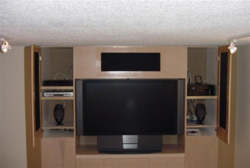 |


TechnoFILE is copyright and a registered trademark © ® of
Pandemonium Productions.
All rights reserved.
E-mail us Here!

Retrofitting - Home Theatres Don’t Have to Take Over Your RoomBy Jim Bray How hot are home theatres? Extremely, if the number of flourishing electronics retailers - and DVD titles - are any indication. “It’s becoming a hobby,” says Darren Lane of K&W Home Automation in Calgary, Alberta. “It crosses all demographics and is something the whole family can use.” Why? Have movie theatres priced themselves out of the market? Or has the technology merely come of age. Yes. A night out can be expensive, what with ticket prices, food, baby sitter, gasoline, etc. If you like watching movies, investing that cash into your own theatre can make sense. And the technology really has advanced so that you can have a better movie experience at home than in the neighbourhood cinema. Prices have come down, too, as capabilities have gone up. But what if you don’t want to destroy your room’s existing look by loading it with hulking TV’s and speakers, and a pasta salad of wires? “We wanted our home theatre’s speakers hidden to leave room for pictures,” says Calgarian Justin Norris, “And the wires tucked away to keep our young one from tripping over them.” Others may just want an unobtrusive big screen TV. Tall orders? Not necessarily. “Anything can be done,” says Lane. It only takes money and, though retrofitting is often more expensive than building a theatre in an undeveloped room, there are strategies that can save you some cash. But the first step should be to consult a pro to discuss what you want and how to accomplish it. “This should include drawing up a floor plan, preferably right there in your house,” says Jim Gray of A/V Basics in Calgary, whose company did Norris’ installation. First, decide where you want the electronics, including speakers, and what type of video display you prefer - colossal rear projector, elegant front projector or wall-hanging plasma. The trend when retrofitting is toward plasmas or liquid crystal (LCD) front projectors, though both have downsides. Plasma is expensive and limited to about sixty inches (measured diagonally). And while front projectors can offer breathtaking screen sizes, they require strict control of the room lighting and so may not be practical in bright rooms. You also need to hang the projector (hiding its wires) and screen. Projection screens can roll up when not in use, or mount directly on the wall behind curtains or doors. You should also decide where to put, and how to wire, the speakers. You need 5.1 or 7.1 audio channels, so besides the main stereo speakers you’ll want a front centre channel, two to four surround speakers, and a subwoofer. Subwoofers are hefty boxes, but their placement is flexible so they’re easily hidden - even in plain sight. The remaining speakers can be hung out of the way or, if you want them to truly disappear, they can be installed right into the wall – with or without visible grilles. As for the stack of amplifier, DVD player, etc. “Electronics define their own space,” Lane says, “And only a few areas in most retro installations are suitable for putting a rack once other considerations are taken into account.” If you’re planning to use a big armoire or cabinet to house your electronics, Gray reminds you to “Make sure there’s access to the connectors on the rear of the components” to hook in the multitude of wires and cables. Speaking of wires and cables, speaker wires can be strung to ensure your room doesn’t look like a spaghetti farm but, Lane warns, “Retrofitting wiring to minimize damage to the existing structure is potentially the most time consuming and expensive” because it involves removing moldings, finding fire breaks, etc. On the upside, the cost can be reduced by demolishing a wall, as opposed to the more time consuming method of cutting holes in the walls and feeding the cables through. And though bulldozing your walls may not seem like the best way to maintain the original look, they can be rebuilt to match their original appearance once everything’s installed. Wiring can also be hidden by putting “tracking” over the existing drywall, stringing the wires outside the old wall, and adding a new drywall or fabric layer outside. This cuts down slightly on the room’s size, but it works. It also lets you add sound deadener into the wall. There are easier ways, too. “Wires can be hidden under the carpet or, if the basement isn’t developed, they can be strung through the floor to the basement below,” says Gray, adding that baseboards can also be pulled off and wires run behind, “though that’s more labour intensive.” You should also think about sound quality and soundproofing. Rooms often require some kind of damping or sound traps to smooth out the sound. And to keep your home theatre from annoying the neighbours, materials like Isobloc - a rubbery substance denser than lead that installs right inside the wall - can help contain your noise. This can be difficult in some retrofits, however. The cost of such installations can be anything imaginable, though Lane estimates the average retrofit falls in the $20,000 to $30,000 range. A lot of money, perhaps, and a lot of work, but to many people it’s worth it. “I’m extremely happy,” says Norris of his retrofit. “It’s better than I thought it would be, and it sounds great!”
|
|
|
| Support TechnoFile via Paypal |
| TechnoFILE's
E-letter We're pleased to offer our FREE private, subscription-based private E-mail service. It's the "no brainer" way to keep informed. Our Privacy Policy |